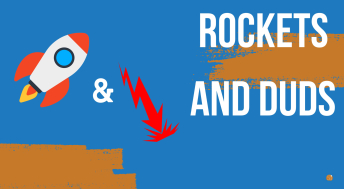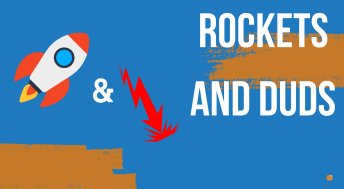The TSX composite index declined 4.6% during the month and 13% YTD. While this was not a terrific performance, it was significantly better than the major US Indexes. The principal contributor to this decline was the aggressive stance taken by the Central banks who promised to continue hiking rates going forward in order to fight inflation.
In Canada, headline inflation came in slightly below expectation and GNP growth slowed but remained positive (barely). Real household income remained above the trend in Canada, but consumption will be weakened by rising interest rates. Retail sales declined 2.5% in July as Canadians began to react to rising interest rates. Globally, China is sticking to its zero covid policy and the Ukraine imbroglio continues although both seem to be going a little better. Supply constraints are responsible for a significant share of inflation and the relaxation of China's Covid policy would help. Notably, the Canadian dollar fell some 6% in September as the US dollar strengthened. With this background, the following table depicts the top and bottom stock performers during the month.
The best performer was Dye & Durham Limited (DND) whose stock was up 22.76% on the month, but down 62.19% YTD. It had been dropping throughout the year and was the third-worst performer last month. It is a leading provider of cloud-based software and technology solutions designed to improve efficiency and increase productivity for legal and business professionals. On September 23rd, DND announced that it was abandoning its year-long efforts to secure the $3.2 billion Link acquisition in Australia. On September 26th it announced its 3-month and fiscal year ended June 30, 2022 results, which was quite good. Revenue for the three months was $129.7 million, an increase of $45.3 million or 54%, compared to the corresponding prior period; Revenue for the fiscal year was $474.8 million, an increase of $265.9 million or 127%. Net income for the year was $7.8 million, up $48.7 million although net income for the last quarter was negative $3.3 million due principally to higher amortization expenses. Adjusted EBITDA for the three months ended June 30, 2022, was $75.2 million, an increase of $26.0 million or 53% compared to the prior period; For the fiscal year, it was $266.9 million, which was up $150.6 million, or 129%. $202.8 million in cash was used during the year, (primarily in support of $883 million of acquisitions) leaving $223.6 million on hand. DND’s strategy is to become a $1 billion adjusted EBITDA company chiefly through acquisitions, buttressed by developing necessary technology products. It will still need to get its expenses under better control before its p/e ratio is raised to levels more appropriate to a high-growth company.
The second-best performer was Absolute Software Corporation (ABST) whose stock was up 13.91% in the month and 37.44% YTD. It was the second-best performer last month as well. ABST is a leading provider of self-healing endpoint and secure access solutions. This involves the only undeletable defense platform embedded in more than half a billion devices, which helps customers protect against the escalating threat of ransomware and malicious attacks. It enjoys a relationship with over 1,100 partners, including several global carriers and unique integrations with 28 leading PC OEMs (including Dell and HP).
There were no significant developments reported during September although ABST was named an Overall Leader in the 2022 Leadership Compass: Zero Trust Network Access (ZTNA) report, published by KuppingerCole Analysts AG. As well, it announced it had entered into a partnership with Trellis Endpoint Security. Presumably, the acquisition of NetMotion (July 2021)continues to enable a reliable, resilient work-from-anywhere experience by ensuring maximum security and uncompromised productivity while enforcing Zero Trust principles. An analysis of the August balance sheet indicates that the debt-equity ratio is much too high because Equity is too small as it has been eroded by prior period losses.
The increasing volume and velocity of data breaches and cyber threats have accelerated the demand for resilient security platforms. For the full fiscal year 2023 (ended June 30), management is projecting EBITDA growth of 21 to 24%.
The third best performer was Aritzia Inc whose stock was up 8.7% on the month, but down 9.26% YTD. It reached a high of $59.75 in early January 2022 and was the top performer in that month; subsequently, it fell to a low of $32.85 in mid-June from which it has since climbed to $45.39 in late September. This is a vertically integrated design house offering everyday luxury clothing online and through some 106 boutiques (38 in the US). It is a creator and purveyor of Everyday Luxury clothing, home to an extensive portfolio of exclusive brands for every function and individual aesthetic.
It is not clear what pushed the stock price down earlier this year, but the pretty decent results published on July 7th probably buttressed the rising price since. Net revenue for the first quarter of fiscal 2023, ending May 29, 2022, at $407.9 million was up 65.2% compared to the comparable prior year period. The unprecedented acceleration of sales in the USA (up 81% to $206.8 million) contributed heavily to this result. Net income at $33.3 million was up 85.8% and adjusted EBITDA at $69.6 million was up 70.3%
Management believes strong momentum is continuing particularly in the US and is projecting net revenue for fiscal 2023 to be up 25 to 27% in the range of $1.875 to $1.9 billion. Brian Hill, the CEO, created this company in 1984 and controls it through his holding of multiple voting shares. He continues to do a remarkable job.
The third worst performer this month was Sylogist Ltd (SYZ) whose stock price was down 18.2% in September and 57.1% YTD. SYZ is a customer-focused Software-as-a-Service (“SaaS”) technology innovation company that provides cloud-based software solutions to a wide range of public sector enterprises, primarily in North America. It provides comprehensive, mission-critical, enterprise resource planning (“ERP”) and constituent relationship management (“CRM”) solutions, such as fund accounting, donor engagement, and grant management. The stock had a high of $17.69 in late April and drifted down some 69% since. It follows the “Rule of 40” which targets a long-run expected combined blend of revenue growth rate and EBITDA margin greater than 40. The results announced in May were not spectacular. Results announced on August 11th were better: Revenue for the 3 months ended June 30, 2022 at $13.7 million was up 44%; Profit of $0.895 million compared to a prior loss; adjusted EBITDA at $4.3 million was up 43%. Cash on hand declined $4.2 million in the quarter as $3 million continued to be paid in dividends and $1 million for acquisitions.
SYZ is intent on continuing to grow its business while striving to maintain a Rule of 40 profile. It proposes to continue to integrate in-house developed and acquired technologies to build a cohesive, modular platform of solutions that support customer demands. Management believes that a stronger marketing organization will help and there will be continued development in this area of the organization. It seems to have growth potential but needs to manage cash more conservatively.
Enthusiast Gaming Holdings Inc.
The second worst performer was Enthusiast Gaming Holdings Inc (EGLX) whose stock price was down 31.9% in September and 70.1% YTD. It has had a wild ride this year, with the worst performer in August, the best in May, and 2nd worst in March.
EGLX is building the largest media platform for video game and esports fans to connect and engage with its approximately 300 million gaming enthusiasts worldwide. The Media and Content segment which is comprised of over 100 websites that are wholly owned or exclusively monetized by the company is the most significant producing 89% of total revenue. Central to its ability to create valuable advertising space (referred to as “Inventory”) is the ability to both develop content-rich digital media and foster the interaction and contributions of its users to its digital media properties. To this end, it maintains a network of full and part-time content developers.
Results announced on August 15, 2022, showed revenue at $51.1 million was up 37.7 %; net loss for the period was $16.9 million which was up 32%. It should be noted that the number of shares outstanding increased by some 18% largely to support a $40 million payment to settle deferred and earnout payments. These results were not well received by the market it seems. EGLX bolstered its balance sheet at the end of September by selling $6.8 million of legacy assets and expanding its credit facility by $10 million to $20 million.
EGLX has a complementary organic and acquisition strategy. While acquisitions will continue as an important growth lever, it believes it has a clear path to further monetize the viewership base through multiple organic growth initiatives and the launch of additional products in the near future. This is a volatile and probably not well-understood company that needs to develop tighter controls to survive.
The actual worst performer was Xebec Adsorption Inc (XBC) whose stock price was off 35.44% in September and 79.68 YTD. This is another volatile performer, top in March and worst in May. It provides a suite of product and service offerings for hydrogen and renewable natural gas generation, purification, dehydration, separation, and filtration. It has three targeted markets: biogas conversion to renewable gas (RNG) from agricultural digestors and the like; production of hydrogen; capture of carbon from natural gas streams (CCUS).
The results posted on August 11, 2022, were not great: While revenue at $44.5 million was up 36% over the prior comparable result, net loss of $23.4 million compared to a prior year's gain of $10.2 million. Part of this is related to the remaining completion cost associated with discontinuing the Legacy RNG contracts which amounts to a charge resulting in a net loss impact of $11.9 million and a gross margin impact of $8.3 million. Even excluding this the results were not good and this was confirmed on September 29th when XBC sought creditor protection under the CCA Act and the stock sank.
These are just some of the more than 60 Canadian companies we cover at 5i Research. To view their recent reports you can search for their tickers in the Reports section. If you are not a member and would like to gain access to these reports as well as the Q&A service where you can ask and search questions on these companies, you can fill in your information below to sign up for a free trial.
Take Care,

Disclosure: The analyst(s) responsible for this report do not have a financial or other interest in the securities mentioned.






Comments
Login to post a comment.